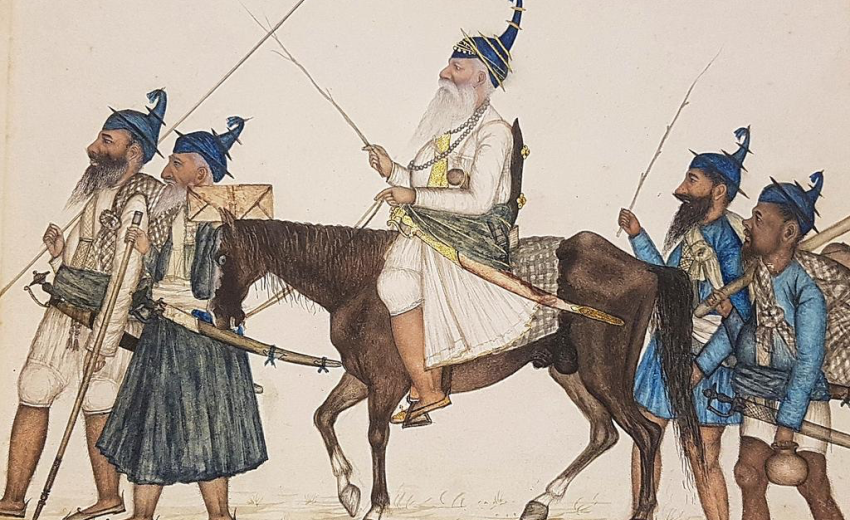Shastar vidya, a martial art, was practised in various regions of the Indian subcontinent long before Sikhism emerged in the mid-16th century. However, it was the Sikh tribes in Punjab who became skilled masters of this combat style. Living in a region surrounded by unfriendly Hindu and Muslim empires that resisted the rise of a new religion, the Sikhs transformed into a highly effective and formidable warrior community.
The Akali Nihangs, a group of fighters identified by their blue turbans, stood out as the most formidable. They not only served as elite troops but also safeguarded Sikh culture and beliefs. When Britain's modern colonial armies expanded throughout the Indian subcontinent, they encountered fierce resistance from the Sikhs. In the 1840s, two intense wars unfolded, ultimately leading to the downfall of the Sikh empire and allowing Britain to extend its Indian territories all the way to the Khyber Pass.
Re-emergence of Shastra Vidya
Impressed by the Akali Nihangs' incredible courage and strength, the British rulers in Punjab took a drastic step by outlawing the group and prohibiting Sikhs from wearing the distinctive blue turbans that were a symbol of the Akalis.
Soon after, Sikh fighters were enlisted into the British military and armed with rifles. The ancient martial art of shastra vidya, which the Akali Nihangs practised, went underground and gradually faded into obscurity. In its place, the British authorities endorsed and promoted "gatka," a more ceremonial and less intense form of shastra vidya. Today, gatka is prominently showcased during Sikh celebrations and festivals.
Practising Shahtra Vidya today
In 2009, three Sikh warriors with turbans on their heads engaged in an intense battle, wielding razor-sharp swords in a well-lit sports gymnasium within a large sixth-form college in Hounslow, west London. These warriors, draped in flowing blue robes and donning chest-length beards, display their skills, cavorting, twisting, and countering with remarkable agility.
The martial art being practised is shastra vidya, a nearly forgotten fighting technique from northern India that faded into obscurity after the British Raj's ban following the Sikh empire's final defeat in the mid-19th century. While Chinese and Japanese martial arts like kung fu and ju-jitsu have flourished as national traditions, shastar vidya, like many other Indian fighting styles, has remained overlooked.
Nidar Singh Nihang, a 41-year-old master who has dedicated two decades to studying shastra vidya's secrets, is determined to revive this art form. His journey, from a factory worker in Wolverhampton to a leading authority on ancient Indian fighting styles, has led him to seek young apprentices willing to commit their lives to preserving this endangered art.
Nidar Singh Nihang's mission to resurrect Shastar Vidiya by passing it on to young British Asians is ironic, considering the historical context. However, he believes that without teaching the original fighting styles, these traditions will vanish within the next 50 years. Nihang's hope is to find a few intelligent, sensible, and tolerant apprentices who can carry forward his knowledge for future generations, ensuring that this unique martial art does not fade into obscurity.
Shastar Vidya: Teaching principles of life
Shastar Vidya is a martial art with deep spiritual and ethical roots that transcends mere combat techniques for its practitioners. It demands strict adherence to religious principles and the honouring of martial codes. While the exact origins of shastra vidya remain shrouded in mystery, there are indications that India's martial arts tradition predates those of China and Japan.
Historical accounts reveal that Indian monks were instrumental in disseminating Buddha's teachings across the Himalayan region. According to Chinese legend, an Indian monk named Bodhidharma played a pivotal role in introducing martial arts to the renowned Shaolin Temple around AD 600. Bodhidharma is believed to have hailed from South India, where another indigenous martial art form, Kalaripayattu, has recently experienced a resurgence.
Iqbal Singh, a 39-year-old businessman from Slough and one of Singh Nihang's prominent students, embarked on a quest to reconnect with his cultural martial heritage. His journey led him to unexpected places, as he found the most knowledgeable source on these ancient fighting styles in a factory worker from Wolverhampton, rather than a traditional old hermit. Interestingly, it was the meticulous record-keeping of the British Raj that enabled individuals like Singh Nihang to rediscover their ancestors' martial legacy. Despite British colonialism's impact on Shastra Vidiya, it is ironically the colonial-era archives, like those found in the British Library and the V&A Museum, that might ultimately preserve this rich tradition for future generations.
*Based on an article by Jerome Taylor, published in The Independent on 13th May 2009
